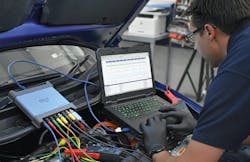SHOP STATS: Complete Car Care Location: Fresno, Calif. Operator: Warren Parr Average Monthly Car Count: 80-100 Number of Lifts: 8 Shop Size: 5,000 square feet Annual Revenue: $700,000
When Warren Parr opened his shop, Complete Car Care, in Fresno, Calif., back in 1985, his son was born around the same time. Throughout his son’s childhood, Parr always hoped his son would become part of his business—he was practically raised in the shop, building his first engine at the age of 13, and becoming a master technician at just 21. But, two years later, his son decided to go down a different path and work for the government; it paid a lot more and required less work. What originally started as a way to get his son back to the shop became a way to bond local shops together and close the technician gap.
The Problem
Soon after learning his son would change careers, Parr realized this same issue is a concern for a majority of the industry, and wanted to find a way to make auto repair appealing again. To do this, he began paying attention to technology and how it could appeal to younger generations. This is when Parr came across PicoScope technology, a diagnostic tool using waveforms (essentially an X-ray machine of automotive diagnostics). This technology would create opportunities to charge more and pay better wages at his own shop and—instead of keeping this knowledge to himself—he wanted to share what he’d learned to make PicoScope technology the new standard in automotive repair.
The Solutions
Creating a Common Goal
Parr first started attending career fairs to share the technology with potential students, putting the pico technology on full display with eye-catching activities to demonstrate the technology.
“If you’re going to catch fish, you have to have bait,” Parr says.
While it was a great start to get students interested, he needed to get other shop owners on board. One owner in particular had been running into issues at his shop and asked Parr to help with the PicoScope. After five minutes, Parr had a diagnosis. The owner couldn’t believe it at first, but from then on, he was converted. Parr then told him how it’s always been his dream to start a club, where shop owners could come together to share their case studies and waveforms.
“The next thing I know, he set up a meeting at the shop,” Parr says.
The Pico Club held its first meeting on January 3, 2009, with 13 members. Now, with over 30 members, the club holds meetings on the first Saturday of every month. The club also has a private Facebook page where members can post questions or updates.
“When they learn something, we can share it with everybody, and when someone has an issue, we can all work together to help them work it out,” Parr says.
The only thing the club doesn’t discuss is pricing to avoid creating price-fixing issues.
Partnering on Education
Parr’s next step? Getting this technology into public education curricula. Parr called the local high school superintendent and asked if he could be an advisor for the automotive programs—there are only two in the city of a quarter of a million people. Parr has now become the advisor for the entire county’s nine high schools with automotive programs.
The superintendent also confirmed that teachers in the area were interested in learning more about the technology. Now, the club teaches it to those teachers in order to supply students with a more modern skill set that will allow them to go from the shop back to school and apply what they’ve learned. Parr says there are at least seven in the club that have high school juniors and seniors from the local vocational high school now working in their shops two days per week.
The Aftermath
Back at the beginning of 2020, the Pico Club began its long-term relationship with their county public high schools with its first-ever workshop. Now, small auto repair businesses are partnering with local school districts not just in an advisory role, but as instructors and on the school’s curriculum.
Parr is the president of his NAPA business development group in California, one of 64 NAPA groups around the country. What the Pico Club is now trying to do is build an education model surrounding Pico Technology and give it to NAPA to share.
“How I see it is, the more minds working on it, the better it will become,” Parr says.
The Takeaway
Parr says if everything goes well with the PicoScope curriculum, they expect to see more talent in their shops in the next three years.
“We want students to learn this technology so they will get a higher wage when they get out into the working world,” Parr says. “We have to do it faster, we have to do it better, and with this scope, it makes it possible.”



